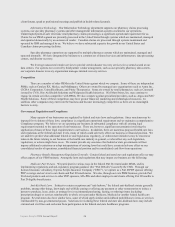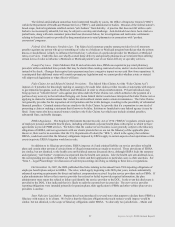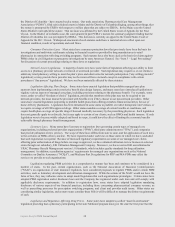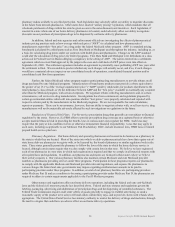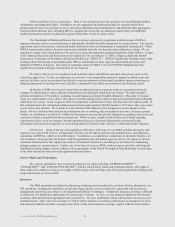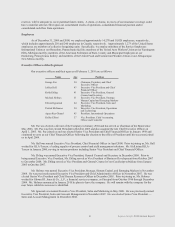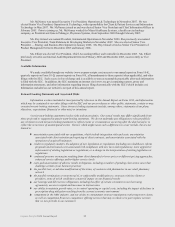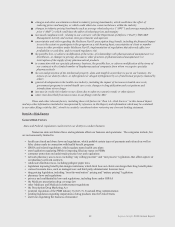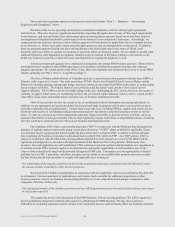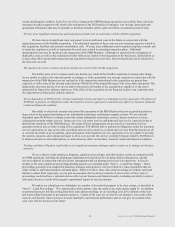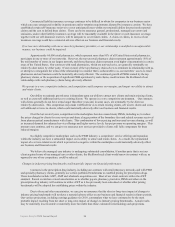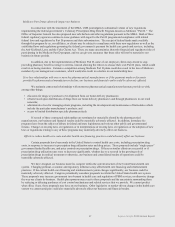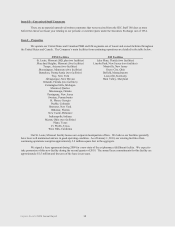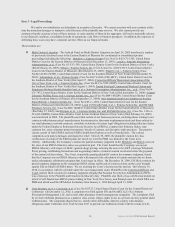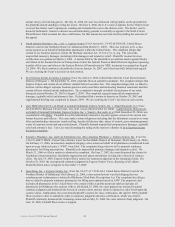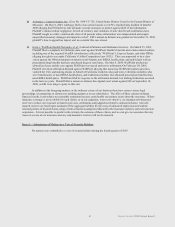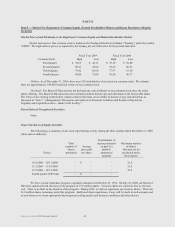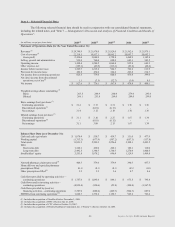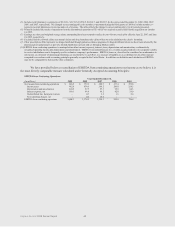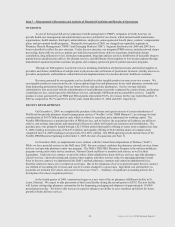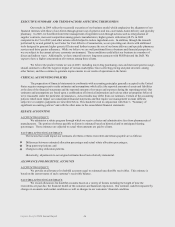Express Scripts 2009 Annual Report Download - page 38
Download and view the complete annual report
Please find page 38 of the 2009 Express Scripts annual report below. You can navigate through the pages in the report by either clicking on the pages listed below, or by using the keyword search tool below to find specific information within the annual report.
Express Scripts 2009 Annual Report 36
Commercial liability insurance coverage continues to be difficult to obtain for companies in our business sector
which can cause unexpected volatility in premiums and/or retention requirements dictated by insurance carriers. We have
established certain self-insurance reserves to cover anticipated losses within our retained liability for previously reported
claims and the cost to defend these claims. There can be no assurance general, professional, managed care errors and
omissions, and/or other liability insurance coverage will be reasonably available in the future or such insurance coverage,
together with our self-insurance reserves, will be adequate to cover future claims. A claim, or claims, in excess of our
insurance coverage could have a material adverse effect on our business and financial results.
If we lose our relationship with one or more key pharmacy providers, or our relationship is modified in an unfavorable
manner, our business could be impaired.
Approximately 60,000 retail pharmacies, which represent more than 95% of all United States retail pharmacies,
participate in one or more of our networks. However, the top ten retail pharmacy chains represent approximately 50% of
the total number of stores in our largest network, and these pharmacy chains represent even higher concentrations in certain
areas of the United States. Our contracts with retail pharmacies, which are non-exclusive, are generally terminable on
relatively short notice by either party. If one or more of the top pharmacy chains elects to terminate its relationship with us,
or attempts to renegotiate the terms of the relationship in a manner that is unfavorable to us, our members’ access to retail
pharmacies and our business could be materially adversely affected. The continued growth of PBMs owned by the top
pharmacy chains, or the acquisition of significant PBM operations by such chains, could increase the likelihood of our
relationships with such pharmacy chains being adversely affected.
We operate in a very competitive industry, and competition could compress our margins, and impair our ability to attract
and retain clients.
Our ability to maintain growth rates is dependent upon our ability to attract new clients and retain existing clients,
as well as cross-sell additional services to existing clients. We operate in a very competitive environment. Our contracts
with clients generally do not have terms longer than three years and, in some cases, are terminable by the client on
relatively short notice. This competition may make it difficult for us to retain existing clients, sell to new clients and cross-
sell additional services to clients, which could materially adversely affect our business and financial results.
Over the last several years, competition in the marketplace has also caused many PBMs, including us, to reduce
the prices charged to clients for core services and share a larger portion of the formulary fees and related revenues received
from pharmaceutical manufacturers with clients. This combination of lower pricing and increased revenue sharing, as well
as increased demand for enhanced service offerings and higher service levels, has put pressure on operating margins. This
pressure may continue, and we can give no assurance new services provided to clients will fully compensate for these
reduced margins.
In a highly competitive marketplace such as the PBM industry, a competitors’ service offering and reputation
within the industry can have a substantial impact on its ability to attract and retain clients. As a result, the reputational
impact of a service-related event which is perceived as negative within the marketplace could materially adversely affect
our business and financial results.
We believe the managed care industry is undergoing substantial consolidation. If another party that is not our
client acquired some of our managed care or other clients, the likelihood such client would renew its contract with us, as
opposed to one of our competitors, could be reduced.
Changes in industry pricing benchmarks could materially impact our financial performance.
Contracts in the prescription drug industry, including our contracts with retail pharmacy networks and with PBM
and specialty pharmacy clients, generally use certain published benchmarks to establish pricing for prescription drugs.
These benchmarks include AWP, AMP and wholesale acquisition cost. Most of our client contracts utilize the AWP
standard. Recent events have raised uncertainties as to whether payors, pharmacy providers, PBMs and others in the
prescription drug industry will continue to utilize AWP as it has previously been calculated or whether other pricing
benchmarks will be adopted for establishing prices within the industry.
Due to these and other uncertainties, we can give no assurance that the short or long-term impact of changes to
industry pricing benchmarks will not have a material adverse effect on our business and financial results in future periods.
Our various projections, including earnings guidance for 2010, contemplate what we have estimated to be the most
probable impact resulting from the short or long-term impact of changes to industry pricing benchmarks. Actual results
may be materially less favorable or materially more favorable than those estimated in formulating such projections.


